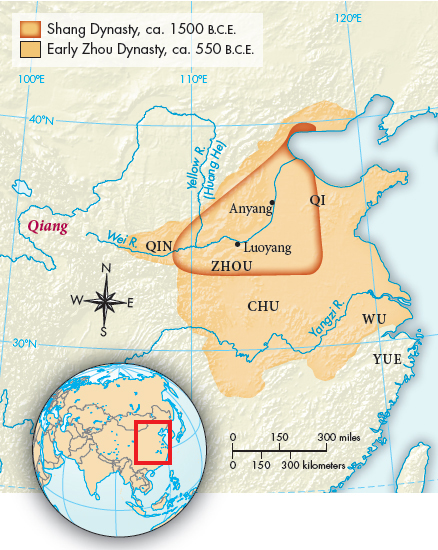Understanding World Societies:
Printed Page 93
Shang Society

Shang civilization was not as densely urban as that of Mesopotamia, but Shang kings ruled from large settlements (Map 4.2). The best excavated is Anyang, from which the Shang kings ruled for more than two centuries. At the center of Anyang were large palaces, temples, and altars. Outside the central core were industrial areas where bronzeworkers, potters, stone carvers, and other artisans lived and worked. Beyond these urban settlements were farming areas and large forests.
Texts found in the Shang royal tombs at Anyang show that Shang kings were military chieftains. They fought rebellious vassals and foreign tribes, but the situation constantly changed as vassals became enemies and enemies accepted offers of alliance. War booty was an important source of the king’s revenue, especially the war captives who could be made into slaves.
Bronze-
Shang power did not rest solely on military supremacy. The Shang king was also the high priest, the one best qualified to offer sacrifices to the royal ancestors and the high god Di. Royal ancestors were viewed as able to intervene with Di, send curses, produce dreams, assist the king in battle, and so on. The king divined his ancestors’ wishes by interpreting the cracks made in heated cattle bones or tortoise shells prepared for him by professional diviners.
Shang palaces were undoubtedly splendid but were constructed of perishable material like wood, and nothing of them remains today, giving China none of the ancient stone buildings and monuments so characteristic of the West. What has survived are the lavish underground tombs built for Shang kings and their consorts.
The one royal tomb not robbed before it was excavated was for Lady Hao, one of the many wives of the king Wu Ding (ca. 1200 B.C.E.). The tomb was filled with almost 500 bronze vessels and weapons, over 700 jade and ivory ornaments, and 16 people who would tend to Lady Hao in the afterlife. Human sacrifice did not occur only at funerals. Inscribed bones report sacrifices of war captives in the dozens and hundreds.
Shang society was marked by sharp status distinctions. The king and other noble families had family and clan names transmitted along patrilineal lines, from father to son. Kingship similarly passed along patrilineal lines. The kings and the aristocrats owned slaves, many of whom had been captured in war. In the urban centers there were substantial numbers of craftsmen who worked in stone, bone, and bronze.
Shang farmers were obligated to work for their lords (making them essentially serfs). Their lives were not that different from the lives of their Neolithic ancestors, and they worked the fields with similar stone tools. They usually lived in small, compact villages surrounded by fields.